CHAPTER 2: MEASUREMENT
2-2: US Customary System: Volume and Capacity
Volume and Capacity
Volume and capacity are often used interchangeably in conversation but are in fact very different concepts. While volume is a measure of the amount of 3-dimensional space an object takes up, capacity is a measure of how much substance a 3-dimensional object can hold.
 Measuring Volume
Measuring Volume
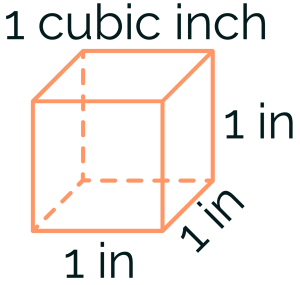 Volume is the amount of 3-dimensional space taken up by an object and is measured in cubic units. A cubic inch (i.e., 1 in3) is a cube with dimensions 1 inch by 1 inch by 1 inch. A cubic foot (i.e., 1 ft3) is a cube with dimensions 1 foot by 1 foot by 1 foot. A cubic yard (i.e., 1 yd3) is a cube with dimensions 1 yard by 1 yard by 1 yard. In general, a cube with dimensions of 1 unit by 1 unit by 1 unit has a volume of 1 cubic unit. Such a cube is called a unit cube.
Volume is the amount of 3-dimensional space taken up by an object and is measured in cubic units. A cubic inch (i.e., 1 in3) is a cube with dimensions 1 inch by 1 inch by 1 inch. A cubic foot (i.e., 1 ft3) is a cube with dimensions 1 foot by 1 foot by 1 foot. A cubic yard (i.e., 1 yd3) is a cube with dimensions 1 yard by 1 yard by 1 yard. In general, a cube with dimensions of 1 unit by 1 unit by 1 unit has a volume of 1 cubic unit. Such a cube is called a unit cube.
Explore 1 – Appropriate measures
1. What is an appropriate measurement unit to describe the volume of a basketball?
Solution
Cubic inches
2. What is an appropriate measurement unit to describe the volume of a parcel?
Solution
Cubic inches or cubic feet
3. What is an appropriate measurement unit to describe the volume of a hot-air balloon?
Solution
Cubic feet or cubic yards
Explore 2 – Calculating volume
The formula to calculate volume is ![]() . The formula shows the number of unit cubes in a row (suppose this is the length) times the number of unit cubes in a column (suppose this is the width) times the number of layers (the height). The result is the number of cubes in a three-dimensional space. For example, a space with length = 10 ft, width = 8 ft, and height = 7 ft has a volume of
. The formula shows the number of unit cubes in a row (suppose this is the length) times the number of unit cubes in a column (suppose this is the width) times the number of layers (the height). The result is the number of cubes in a three-dimensional space. For example, a space with length = 10 ft, width = 8 ft, and height = 7 ft has a volume of ![]() unit cubes, where each cube has the dimensions 1 foot by 1 foot by 1 foot. Since there are fifty 1 foot by 1 foot by 1 foot cubes in the space, we say the volume is 50 cubic feet or 50 ft3.
unit cubes, where each cube has the dimensions 1 foot by 1 foot by 1 foot. Since there are fifty 1 foot by 1 foot by 1 foot cubes in the space, we say the volume is 50 cubic feet or 50 ft3.
- Calculate the volume of a fish tank that measures 40 inches (length) by 30 inches (width) by 20 inches (height).
Solution
Volume = ![]() in3
in3
- Calculate the volume of a box that measures 2
 3
3 by 3
by 3 4
4 by 10
by 10 in both cubic inches and cubic feet.
in both cubic inches and cubic feet.
Solution
2![]() 3
3![]() = 2 · 12
= 2 · 12![]() + 3
+ 3![]() = 27
= 27![]()
3![]() 4
4![]() = 3 · 12
= 3 · 12![]() + 4
+ 4![]() = 40
= 40![]()
Volume = 27i n · 40 in · 10 in = 10, 800 in3
2![]() 3
3![]() =
= ![]()
3![]() 4
4![]() =
= ![]()
10![]() =
= ![]()
Volume = ![]() ft3
ft3
Explore 3 – Basic volume unit conversion
- Explain why 1 yd3 = 27 ft3. Draw a picture to help you.
Solution
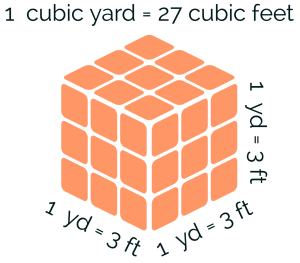 Since there are three
Since there are three ![]() cubes on the length and width of a
cubes on the length and width of a ![]() cube, there are
cube, there are ![]() of
of ![]() cubes (i.e., 9 ft3) in a single layer of a
cubes (i.e., 9 ft3) in a single layer of a ![]() cube. Since there are 3 layers (1 foot per layer), there are
cube. Since there are 3 layers (1 foot per layer), there are ![]() of
of ![]() cubes (i.e., 27 ft3) in a
cubes (i.e., 27 ft3) in a ![]() cube (i.e., 1 yd3).
cube (i.e., 1 yd3).
- Explain why 1 ft3 = 1728 in3. Draw a picture to help you.
Solution
Since there are twelve ![]() ) cubes on the length and width of a
) cubes on the length and width of a ![]() cube, there are
cube, there are ![]() of
of ![]() cubes (i.e., 144 ft3) in a layer of a
cubes (i.e., 144 ft3) in a layer of a ![]() cube. Since there are 12 layers (1 inch per layer), there are
cube. Since there are 12 layers (1 inch per layer), there are ![]() of the
of the ![]() cubes (i.e., 1960 in3) in a
cubes (i.e., 1960 in3) in a ![]() cube (i.e., 1 yd3).
cube (i.e., 1 yd3).
- Some stores measure the size of fish tanks in cubic feet. Calculate the volume of a fish tank that measures 40 inches (length) by 30 inches (width) by 20 inches (height) to the nearest cubic foot.
Solution
![]() in3.
in3. ![]() . So, the volume is about 14 ft3.
. So, the volume is about 14 ft3.
- The bed of a pick-up truck has dimensions 6′ (width) by
 (length) by 22″ (depth). Find the volume in cubic feet.
(length) by 22″ (depth). Find the volume in cubic feet.
Solution
Volume ![]() ft3.
ft3.
- A medium suitcase has dimensions 10.25″ by 16.75″ by 24″. Find the volume in cubic inches.
Solution
Volume ![]() in3.
in3.
- How many medium suitcases at most can fit into the bed of the pick-up truck with the dimensions described in questions 4 and 5.
Solution
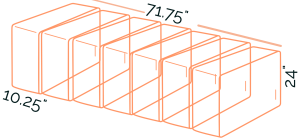 Let’s assume the suitcases can stick up above the sides of the truck bed by 2 inches. The suitcases are 10.25 inches wide so 7 can stand up across the width of the truck bed (72″/10.25″=7.0). The length of the truck bed is 78 inches so can fit 4 suitcases (78″/16.75″=4.6). Therefore, the truck can carry
Let’s assume the suitcases can stick up above the sides of the truck bed by 2 inches. The suitcases are 10.25 inches wide so 7 can stand up across the width of the truck bed (72″/10.25″=7.0). The length of the truck bed is 78 inches so can fit 4 suitcases (78″/16.75″=4.6). Therefore, the truck can carry ![]() =28 suitcases.
=28 suitcases.

- Explain why a volume measurement unit contains the word cubic.
Show/Hide Answer
The word cubic describes a real cube with each side measuring 1 unit. Volume is determined by the number of unit cubes that fit into the 3-dimensional space. In addition, volume is basically a product of the length, width, and depth of an object, so the measurements are unit · unit · unit = cubic units.
Practice Exercises – Volume
- What is an appropriate unit to measure the volume of a child’s balloon?
- A Rubik’s Cube measures 3 inches on each side. What is the volume of the Rubik’s Cube?
- The iPhone 14 Pro Max has dimensions 6.33″ by 3.05″ by 0.31″. Calculate the iPhone’s volume to the nearest cubic inch.
-

Tête Carrée The Tête Carrée (Square Head) Building in Nice, France has dimensions 27.7 yards on each side of the cube. It houses a library on 3 floors within the cube. Calculate the volume of the cube to the nearest cubic yard.
- A bass speaker measures 14 in by 22 in by 10.5 in. Calculate the volume of the speaker.
Show/Hide Answers
- Cubic inches
- 27 in3
- 6 in3
- 21,254 yd3
- 3234 in3
 Measuring Capacity
Measuring Capacity
Capacity is the maximum amount that a 3-dimensional object can contain. It is the measure of an object’s ability to hold a substance. Capacity and volume are related, but while volume is the amount of 3-dimensional space taken up by an object and is measured in cubic units, capacity is measured in units that are appropriate to what is put into the object. Generally, they are gallon, quart, pint, cup, fluid ounce, tablespoon, and teaspoon. The relationship between the sizes of the units may be represented by the unit conversion equations:
Measures of Capacity
1 gallon (gal) = 4 quarts (qt)
1 quart (qt) = 2 pints (pt)
1 pint (pt) = 2 cups (c)
1 cup (c) = 8 fluid ounces (fl. oz.)
1 fluid ounce (Fl. Oz.) = 6 teaspoons (tsp) = 2 tablespoons (Tbsp)
1 tablespoon (Tbsp) = 3 teaspoons (tsp)
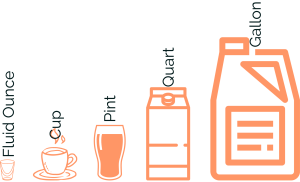
Explore 4 – Appropriate measures for capacity
- What is an appropriate unit to measure the contents of a carton of orange juice?
Solution
Carton implies waxed paper box, so pints, quarts, or fluid ounces are appropriate.
- What is the appropriate unit to measure the amount of water a fish tank will hold?
Solution
Fish tanks tend to be decently sized, so gallons
- What is the appropriate unit to measure the amount of vanilla to add to a cookie recipe?
Solution
Only a small amount of vanilla is added to cookies, so teaspoon or tablespoon are appropriate.
- What is the appropriate unit to measure a glass of beer?
Solution
Beer is usually served in pints but could also be measured in fluid ounces.
Explore 5 – Basic capacity unit conversion
Nina drinks one cup of milk per day. Nina enjoys fresh milk and likes to finish a carton of milk within a week of purchase. Nina goes shopping once a week. How many and what size of cartons(s) should Nina buy? Milk is sold in gallons, half-gallons, quarts, pints and half-pints. Explain your reasoning.
Solution
Nina drinks 7 cups of milk per week. Since there are 2 cups in a pint, Nina drinks 3.5 pints per week (7/2 = 3.5). Since there are 2 pints in a quart, 3.5 pints = 1 quart 1.5 pints. So, Nina should buy 1 quart, 1 pint, and 1 half-pint of milk. Alternatively, Nina can buy 1 quart and three half-pints of milk.
Explore 6 – Basic capacity unit conversion
Gasoline is typically sold by the gallon. Steve has a 16.2 gallon gas tank in his truck. How many pints of gas will his gas tank hold?
Solution
Since 1 gallon = 4 quarts and 1 quart = 2 pints, 1 gallon = 4 · 2 pints = 8 pints.
Therefore, a 16.2 gallon gas tank has the capacity of 16.2(8 pints) = 129.6 pints of gas.

- What is the relationship between volume and capacity?
Show/Hide Answer
Volume measures the amount of 3-dimensional space an object takes up. Capacity measures the amount of liquid that the object can hold.
- What is the difference between the units used to measures volume and capacity?
Show/Hide Answer
Volume is measured in cubic units while capacity is measured in fluid ounces etc.
Practice Exercises – Capacity
- What is the appropriate unit to measure the amount of sugar Janet puts in her tea?
- What is the appropriate unit to measure the amount of ice-cream in a tub?
- Clay’s fish tank has a capacity of 40 gallons of water. How much water is this in pints?
- The capacity of a Camelbak Mule hydration pack is 100 fluid ounces. How many pints is this?
- How many quarts of water can be stored in a 5 gallon water jug?
- Sally is tripling a recipe that calls for 2 tsp of orange flavoring. She only has a tablespoon to measure with. How many tablespoons should she use?
Show/Hide Answers
- Teaspoons
- Pints, quarts, or gallons
- 320 pints
- 6.25 pints
- 20 quarts
- 2 Tbsp
 In this section, we will take what we have learned and apply the concepts to new situations.
In this section, we will take what we have learned and apply the concepts to new situations.
Perspectives
- Brooke needs to mail 6 books. Each book measures 9 inches by 6 inches by 1 ½ inches. What is the minimum capacity of the box they will need to ship all six books?
- Kevin is hosting a wine and cheese party for 300 guests. He will serve cubes of cheese that measure 1 in. by 1 in. by 1 in. and figures that each guest will eat 8 cubes of cheese. The blocks of cheese he buys measure 14 in. by 12 in. by 8 in. a) How many cubes of cheese does he need to serve his guests? b) How many cubes of cheese will he get out of one block of cheese? c) How many blocks should he buy for the party?
-
A punch bowl with a capacity of 2 gallons has a 5 fl. oz. ladle. How many ladle scoops would it take to empty a full bowl?
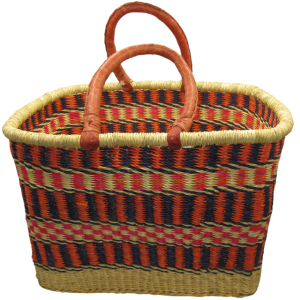
Bolga basket - Lynn is using 8 fl. oz. jars to bottle her homemade jam. If Lynn made 3 gallons of jam, how many jars will she need?
- Chris bought a 3 cases of 12 bottles of wine. Each bottle holds 25.4 fl. oz. How many gallons of wine did they buy?
- In Utah, every foot of snow contains, on average, 1.38 inches of water. What depth of snow is required to obtain 4 inches of water?
- An African bolga basket measures 12″ by 17″ by 11″. Calculate the capacity of the basket.
- Dana needs to order bags of mulch for her garden. She has calculated the area of her garden to be 620 ft2. She wants to put down 3 inches of mulch. a) How many cubic inches of mulch does she need? b) If the mulch is sold in bags containing 3 ft3, how many bags will she need to order? c) As an alternative to buying small bags of mulch, Dana looks into having mulch delivered in bulk. She can have a cubic yard delivered in a large bag. Calculate the volume of mulch she needs in cubic yards. d) How many of these large bags would she need to have delivered?
Show/Hide Answers
- 81 in3
- a) 2400 cubes; b) 1344 cubes; c) 2 blocks
- 52 ladles
- 48 jars
- 7.14375 gallons
- 2.9 feet or 2′ 11″
- 187 in3
- a) 267,840 in3 b) 52 bags c) 5.74 yd3 d) 6 bags
 In this section, we will use what we have learned so far to practice skill problems.
In this section, we will use what we have learned so far to practice skill problems.
Skill Exercises
Calculate the volume of a rectangular solid with dimensions:
- 3 in by 8 in by 5 in
- 4 ft by 9 ft by 15 ft
- 2.3 yd by 7.2 yd by 3.4 yd
- 5 ft by 8 ft by 6 in
- 2 yd by 3 yd by 2 ft
- 6
 by 2
by 2 by 8
by 8
Convert the volume to the given unit:
- 3456 in3 to cubic feet
- 6 ft3 to cubic inches
- 108 ft3 to cubic yards
- 2 yd3 to cubic feet
- 2 yd3 to cubic inches
- 233,280 in3 to cubic yards
Convert from the given unit of capacity to the new unit:
- 40 fluid ounces to pints
- 5 quarts to fluid ounces
- 14 cups to quarts
- 24 tsp to cups
- 0.4 gallons to pints
- 760 fl. oz. to gallons
Show/Hide Answer
- 120 in3
- 540 ft3
- 56.304 yd3
- 20 ft3
- 108 ft3 or 4 yd3
- 1152 in3
- 2 ft3
- 10,368 in3
- 4 yd3
- 54 ft3
- 93,312 in3
- 5 yd3
- 2.5 pints
- 160 fl. oz.
- 3.5 qt
- 0.5 cups
- 3.2 pt
- 5.9375 gallons
a measure of the amount of 3-dimensional space an object takes up

